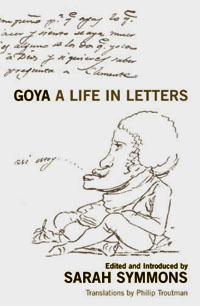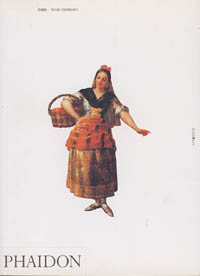Interview 2004 Sarah Symmons-Goubert is a lecturer at the University of Essex. She has had five books published (three on Goya) and organized two international exhibitions on British Romantic Painting and the art of the sculptor John Flaxman. Her book of GOYA: A LIFE IN LETTERS, appeared from Pimlico Press in April, 2004. Our 2006 interview with Dr. Symmons is here.
Question: I noticed in your 1998 book that you firmly back Milkmaid of Bordeaux as a true Goya painting. How have you viewed efforts to have it's authorship changed to Rosario, or to some unknown person altogether? The problem with the Milkmaid of Bordeaux is basically the problem of Goya's very late style, as I see it. Many of the compositional and stylistic anomalies, observed by Juliet Wilson Bareau in her essay about the Milkmaid, can be found in the late etching of 'The Blind Guitarist,' which is a very odd work but its authenticity is rarely if ever questioned. Many artists like Goya who have long working lives produce apparently new styles in their later years (e.g. Titian, Raphael, Daumier) and these can become controversial. Question: With the proliferation of accusations against various Goya works (e.g., The Black Paintings) as being by some other hand, do you have any opinion on what is the driving force for this trend, and the validity of the efforts? I think it's valuable to have such major re-assessments of an artist's work and it has happened to many other major masters in recent years (Poussin and Rembrandt, for example) but the re-authentication of an artist's catalogue raisonne does need to be done sensibly. The question with Goya is that if he didn't paint works like The Colossus, the New York Majas, or the Black Paintings, then we have to find a new artist as their author. If there were such an anonymous artist who for various reasons wanted to keep their identity a secret, then it's a challenge to find out who they were. I know some people have suggested Javier Goya, but I don't believe that. IF he were so talented he would have wanted to claim the credit for such works. If he thought he'd make more money pretending his work was his father's, then he must have been disappointed. The same argument applies to Rosario, although she was obviously not born early enough to have painted most of the disputed pictures. Otherwise there is a very talented forger around and he has been alive for a long time. The argument about the Black Paintings relies rather too heavily, as far as I can gather, on the linguistic history of a particular piece of furniture mentioned in one of the documents. It's all fascinating and ingenious stuff, and doesn't seem to harm Goya's present day popularity, but no-one seems to have thought the details of these re-attributions through properly. Question: Your 1998 book demonstrated a deep level of research into the events that happened around Goya, as well as the events in the mans own life. Since the time you wrote that volume, has there been any change in your evaluation of his work? I think I've come to see the 'Caprichos' as even more peculiarly personal to Goya's concept of what art means than I did before. So many of the satirical themes he explores have occurred in his letters and take form in his prints and drawings. I've also come to admire his amazing memory, particularly in drawings made of things that had happened 40 or 50 years earlier, and he makes them look so fresh and new. If I were to write such a book again I's certainly include more drawings. Question: I note that you were not shy about describing Goya as a genius in your book. The term "genius" seems as much an easy marketing term (in the publishing world) as it is an actual description. What do you think it means to call Goya a genius? Yes, and I got told off for using the word 'genius' by reviewers! Genius is a controversial term, and always was. It has changed meanings a lot over the last 3 centuries. My understanding of Goya's type of genius is rooted in the 18th century when the term changed even more than it has today. Diderot's definition of struggle and controversy relating to creative genius seems very appropriate to Goya, although Diderot is talking about poetic genius: "What does a poet need? Poetry wants something tremendous, barbaric and wild. It is when the fury of civil war or fanaticism puts swords into men's hands, and blood flows in great waves on the ground, that the laurels of Apollo are shaken and become green... They fade away in times of peace and leisure", from an essay on dramatic poetry 1758. The other kind of genius I had in mind concerns the uniqueness of the creative talent. Rousseau wrote in his Confessions: "I am not made like anyone else I have seen. I dare to suggest that I am not made like anyone else who exists. If I am no better, at least I am different." Isn't that a bit like Goya's view of himself as an absolutely original artist? Question: Goya is often classified and spoken of as a modern artist, yet he also seems firmly bedded into the era and place of his life, to the world of Majos and Majas - - is it simply Goya's intelligence or is there some simple basis for his vision that easily transfers to the 20th and now the 21st century? Yes, it's odd isn't it? I think that for many people the grotesque and violent side of Goya’s art seems to have summed up in visual form so many of the preoccupations of the 20th century. It’s particularly noticeable in fiction writing. I came across a reference in John Updike novel to someone suddenly becoming threatening so that they become 'a Goya.' And in a popular thriller an underground room where ritual murders took place was decorated with Goya's Saturn. Perhaps it's too convenient for the morbid 20th century viewer to forget that Goya painted lots of jolly and pretty subjects as well, but I suspect that a lot of these sentiments about Goya came originally from the Surrealists and the way they saw Goya's art. Question: Do you ever get tired of seeing the efforts (Hollywood movies, some Goya writings) made to pair Goya and the Duchess of Alba off as lovers? And what do you think is really meant by "solo Goya" in the sand of the 1797 black portrait? No, I think there's no harm in the way film and fiction have popularised Goya. If it introduces people who have never heard of Goya to his art then these things are worth while. Nobody really knows if Goya and the duchess of Alba loved each other. I think it's unlikely but it’s a nice romantic story. Who knows what the 'Solo Goya' means? It could be a sentimental message or an inscription stating that only Goya could have painted such a magnificent portrait.
Question: Your 1998 book has as its cover a figure from Goya's The PICNIC. It seems most books on Goya stick to a strict iconography of either THIRD OF MAY or MAJA (clothed or nude). Did you make the choice of using the element from The PICNIC for your books cover, and if so, why that particular image? Alas, I had no say in the design of the cover, but I think it's brilliant. Nothing like a pretty girl, and she's a bit more graceful than the nude maja! Question: I saw that the British Cartoonist Society awarded its top yearly prize to a cartoon which took its imagery from Goya's "black painting" SATURN. Also, the Chapman Bros have generated a great deal of news over their using Goya etchings. Do you have any reaction, or ideas why, Goya's imagery continues to go deeper into popular usage? Again, I approve of anything that popularises great works of art, and I really admire the Chapman brothers. I think Goya would definitely have approved of what they have done to his Disasters of War. He took rather similar liberties himself with great works of the past, and isn't it amazing that artists of the 21st century can still find value in someone who died more than 170 years ago? Question: Do you think it is likely there will be further discoveries like the "lost" Goya sketch "Hannibal the Conqueror" which was auctioned at Sothebys in 2000? I'm sure we will find out many more things about Goya in the coming years. I personally will be anxious to see some of the lost letters to Martin Zapater which may well exist somewhere. Question: As you have been studying Goya through your books, have you seen any major changes in Goya scholarship? Yes, a lot of interest in reattribution, of course, a more realistic and less 'venerable' approach. Question: As you worked on the Goya book of his letters, has it altered any of your previous ideas about his work? He writes very well, is quite literary and definitely never went mad. Even his last letters are sensible and intelligent. With regards to his work I have become even more aware of how greatly he prized originality and what a tough time he had to succeed and keep going. Question: While you have studied Goya, have you held any questions that have yet to be satisfied from the available source material that exists (the paintings, drawings & letters)? As I have said above, I look forward to the discovery of more letters and perhaps more sketchbooks. So many of his works have disappeared I am sure many will be discovered. Question: Have you had any sense of personal identification with Goya while you have studied the man for your books? No! Our general page on Dr. Symmons is here. |
- - - - - - - - - - - - - - - - -
- - - - - - - - - - - - - - - - -
WEB
SITE COPYRIGHT©1997-2006 ERIK E. WEEMS
IMAGES ARE COPYRIGHT TO THEIR RESPECTIVE OWNERS
http://www.eeweems.com/goya/interview_symmons.html
BIO | ARTWORK | BOOKS | RESOURCES FOR STUDENTS | LINKS | CONTACT | NEWS | STATS | F.A.Q.


